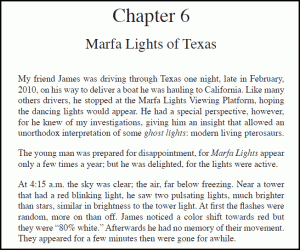Before we begin, be aware that James Bunnell, a retired NASA engineer, has given countless hours during eight years of his life (2001-2009) to investigating the more mysterious types of Marfa Lights, the glowing objects that cannot reasonably be explained away as car headlights or ranch lights or any other common glow at night. Bunnell estimates that only about 3% of unusual lights around Marfa, Texas, are truly mysterious. But those rare lights—how extraordinary!
.

From the cryptozoology book Live Pterosaurs in America (3rd edition)
.
Common sense with things that fly
What would you think about something flying over the bushes near Marfa, Texas, at about 37 miles per hour, for eleven miles, about 250 feet above the ground, silently in daylight? What better explanation than “bird?” It may be unusual for a bird to fly that far at that speed, but if it was tracked and the speed estimated according to triangulation, it would just be common sense to consider it would have been a bird, however uncommon that bird.
What if that object had been tracked by a scientist, at that speed, height, and distance, and still in silence, except that it was in the dark of night? We might still consider a bird or perhaps an unusual bat. Besides identifying it, what general idea might come to mind? Perhaps it might seem a little risky to fly at that speed and altitude, over the bushes and hills, for eleven miles, in the dark of night; but what else could it be other than a creature with wings?
Would it be safer at night, for a winged creature flying 37 miles per hour, for eleven miles, about 250 feet high, to carry around its own light? It would make sense, if possible, for airplanes use lights at night for safety.
Of course airplanes fly much faster, but they also fly much higher than 250 feet above rugged hilly terrain, in the dark of night. But how could any flying creature, bird or bat, glow like a giant firefly? Who ever heard of such a thing?
The point is this: James Bunnell, author of the nonfiction book Hunting Marfa Lights, recorded the flight of a glowing object, something that flew eleven miles, at an average speed that I later calculated was 37 miles per hour, at about 250 feet over the ground, in the dark of night. He did not call it “flight” but he took careful notes and published the event in his book.
I suggest it’s just common sense to consider that object was a bioluminescent winged creature.
Humboldt squid or “Red Devil”
In the Humboldt Current in the Pacific Ocean, a large predatory squid, called diablo rojo by the Mexicans, grows to a length of about five feet. The Humboldt squid has a reputation for attacking humans, although this may occur only when they feed, for as a group they become frenzied, even to the point of attacking one or more of their own kind. They congregate for hunting, sometimes reaching numbers over a thousand.
This huge squid is bioluminescent, with the ability to quickly change body color. During fish hunting, they quickly flash red and white. Bioluminescent flashing has even been observed while a Humboldt squid was out of water, dying on the beach.
Since such large bioluminescent creatures, known by scientists, congregate in such large numbers in the ocean, why could not similar-sized bioluminescent creatures, unknown to scientists, congregate in much smaller numbers, while flying over southwest Texas? Since squid can hunt intelligently while glowing, could not flying creatures hunt intelligently while glowing? I suggest they do.
###
James Bunnell has made great contributions to our knowledge of many details about the most mysterious of what are called “Marfa Lights.” He found several problems with my concept of flying predators hunting bats through a particular hunting technique. But those problems involve that particular technique; they do not distract from the overall concept that a group of bioluminescent flying creatures sometimes search for prey near Marfa, Texas.
.
Marfa Lights to Monstrous Heights
My recent press release (Unmasking a Flying Predator in Texas), to promote my new book (second edition, that is) Live Pterosaurs in America, received indirect attention from the Houston Chronicle, the largest-daily-circulation newspaper . . . [By Sunday circulation, the Houston chronicle is the third-largest newspaper in the United States.]
.
Warmer Nights for Marfa Lights
Of the fifty-two sightings recorded by James Bunnell . . . he included much information in his book, including temperatures when each sighting began. . . . None of those temperatures were below 20 degrees Fahrenheit. About 15% were from 20-40 degrees, 25% were 40-60 degrees, and 58% were from 60-80 degrees . . . This is consistent with a group of nocturnal predators that need to hunt year round, but find it more challenging to find prey on colder nights.
.


